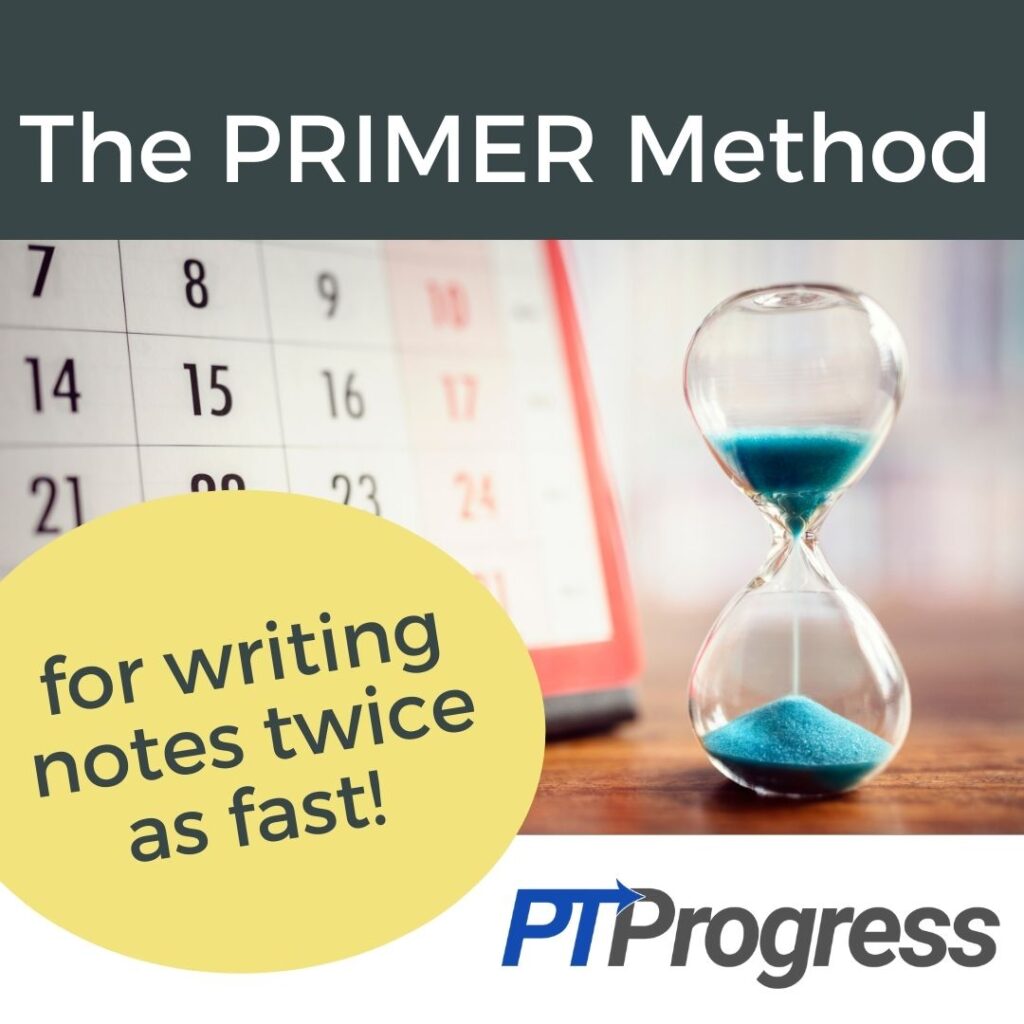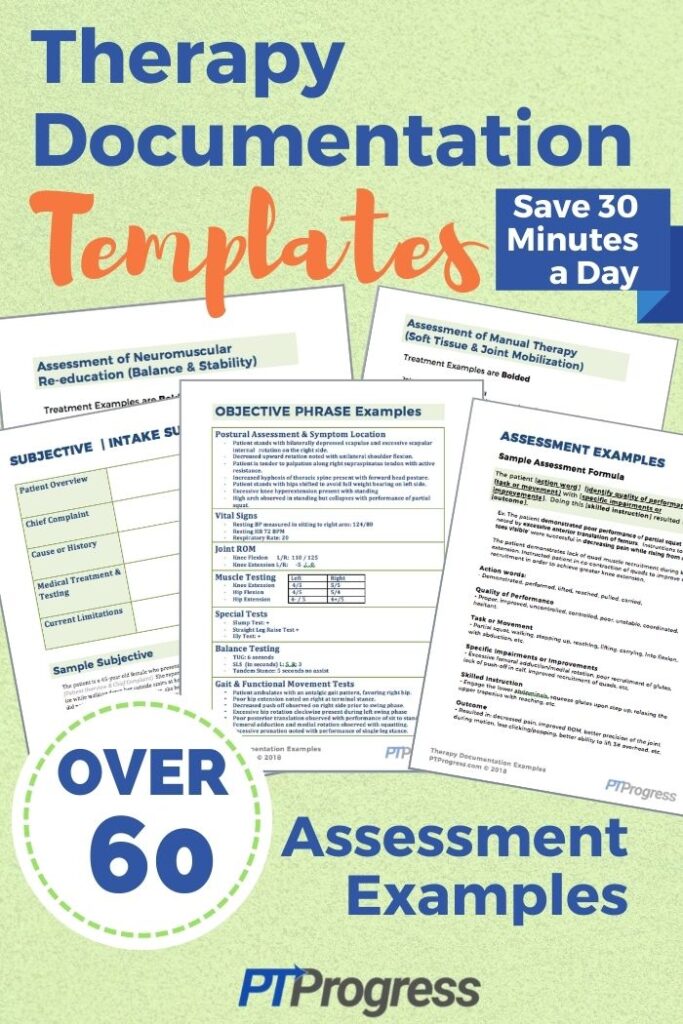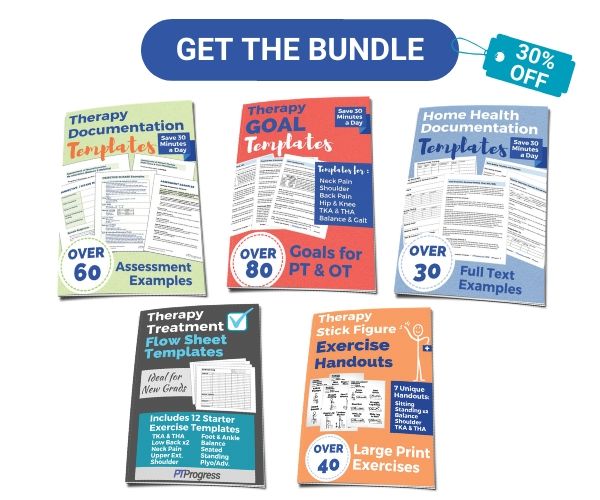
Most people are surprised to learn how much time a physical therapist spends documenting treatments. As a PT myself, I know it’s not uncommon to spend 20 to 30 minutes or more writing up an evaluation note after each visit.
Whether you’re an outpatient physical therapist or you work in home health, you might spend 1-2 hours of your workday typing notes. This burdensome task robs you of time you could spend with your family or enjoying your evenings after work.
The Inefficiencies of PT Documentation
When I started my first job as a PT, I remember staring at the blank sheet of paper with what felt like writer’s block. (Yes, our hospital clinic was still using paper in 2016!) I had just finished 5 treatment sessions and needed to document everything I did – or else there was nothing to show for it.
And with every new patient, my documentation had to start from scratch. I meticulously wrote out each part of a typical SOAP note: the Subjective, Objective, Assessment and Plan. Considering this inefficient, time-consuming task, I knew there had to be a faster way to approach my daily note-writing.

Solution #1: Documentation Templates
To relieve my writer’s block and generate better notes, I developed a system of documentation templates that I still use today. These templates, available here, have helped hundreds of therapists save multiple hours each week on their documentation.
Whether you use my documentation templates or stick to your own, there’s another way you can improve your note-writing. I call it the PRIMER method, a strategy that will both speed up your documentation and enhance the quality of your writing.
Solution #2: The PRIMER Method
The PRIMER method will help you tell the story of your skilled treatment and turn your SOAP-note into a functional masterpiece.
When you sit down to write your notes, think “PRIMER”: an acronym for Identify the Problem, Relate to Activity, Instruct the patient, Manage the response, Educate the patient, and Review the plan.
Let’s look into each of these elements in detail.
P: Identify the Problem
People seek out physical therapy when they have a problem. The first step in documenting your treatment plan is to contextualize the problem that brought your patient into the clinic.
Let’s say your patient has shoulder pain – obviously that’s the problem. You could write something simple, such as “The patient has 5/10 shoulder pain today.” But writing only that for every daily treatment note makes for lazy documentation. It poorly frames the rest of your note and inadequately reflects your skilled treatment.
That’s where the R comes into play.
R: Relate to Functional Activity
Once you’ve identified the problem, relate it to a functional activity. Get in the habit of asking your patient, “Since I saw you last, what kind of activities still give you issues in your shoulder?” A question like that will yield useful answers, and you’ll learn about functional activities that are directly related to the problem.
To include the “R” in your documentation, you could write something like this: “The patient reports improved ability to sleep on her right side but experiences sharp pain in her right shoulder when putting on a shirt.”
With the “P” and “R” in PRIMER, you’ll not only complete the Subjective portion for the day but also find something specific to work on, as opposed to repeating the same generic exercises and treatments for shoulder pain.
At this point, you’re probably 60 seconds into your treatment session. You’ve written your subjective line and come up with some treatments to address their concern. Now it’s time to begin treatment.
I: Instruct the Patient
As you conduct the treatments, you’ll instruct the patient on proper performance of exercises and show them techniques to relieve any symptoms they’re experiencing. The “I” in PRIMER reminds you to write about that in your note, within the objective and assessment sections.
Your instructions help differentiate your skilled treatment from that of a personal trainer, so make notes of the little tips or cues you provide for certain exercises. For example, you could write: “Verbal cues to retract scapula eliminated clicking and pain in shoulder with external rotation.” That’s a great line for your assessment section and leads right into the next part of the PRIMER method.
M: Manage the Response
As a PT, you do this step all the time without thinking about it, right? If the patient says, “Ouch, that hurts when I rotate my arm out,” you instinctively place a towel under their arm so it stops hurting.
Managing the response can also refer to other modifications, such as increasing the difficulty when an exercise is too easy. We do this by adding more resistance or incorporating dynamic stability, for example.
Whether the patient’s response is pain, poor movement quality, or even difficulty comprehending the correct technique, as the therapist you manage the response in order to ensure a useful session. Work that into your assessment to reflect the skilled treatment you provided that day.
E: Educate the patient
This item comes late in the PRIMER acronym, but that doesn’t mean you must wait until the end of the note to mention how you’ve educated the patient. Education occurs throughout the treatment, but it’s easy to overlook and leave out of one’s documentation.
Patient education is an important element to include, and it can fit almost anywhere in the SOAP note.
Maybe at the beginning of the session, your patient asked about wearing a compression sleeve on their shoulder. You can comment on patient education within the subjective portion of that note: “Patient recently purchased a compression sleeve and asked about using it at night. Educated the patient on proper use of the compression sleeve and recommended avoiding use while sleeping.”
Although that line fits well in a subjective section, it could easily belong in the assessment section too. No matter where you write it, the point is that you take time to reflect on patient education and incorporate it into your SOAP note.
R: Review the Plan
A typical SOAP note concludes with a section for your plan. That’s a great place to write out notes for the next session or spell out your recommended treatments for the future.
But don’t forget to review the plan with the patient too. Look over their schedule quickly and confirm the next appointment time. You’ll be surprised how much this can help reduce cancellations and no-shows.
Reviewing the plan with your patient also gives you a chance to review their home exercise program and the exercises that you’re adding or removing to their plan. You can comment on any of those changes within this section of your SOAP note as well.
The PRIMER Method: How it all works together
The point of the PRIMER method isn’t to replace a SOAP note. Rather, it works in tandem with your SOAP note, elaborating more detail.
Below you can see how the PRIMER method supports the structure of a SOAP note:
| P | Identify the Problem | Subjective |
| R | Relate to Functional Activity | Subjective |
| I | Instruct the Patient | Objective/Assessment |
| M | Manage the Response | Assessment |
| E | Educate the Patient | Subjective/Assessment |
| R | Review the Plan | Plan |
The PRIMER method will help you contextualize your notes and relate the patient’s problems to the functional activities that drive the treatments. As a result, your documentation will show how your treatment supports your patient’s goals and how you managed their care with instruction and education.
If you want your documentation to reflect the skilled treatment you provide each day, let the PRIMER method guide your note-writing.
If you want to speed up your notes even more, combine the PRIMER method with the documentation examples and templates available here. You can save over 30% on these templates by choosing the documentation bundle.


